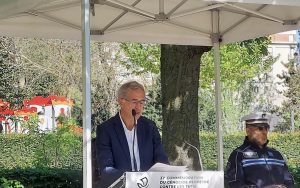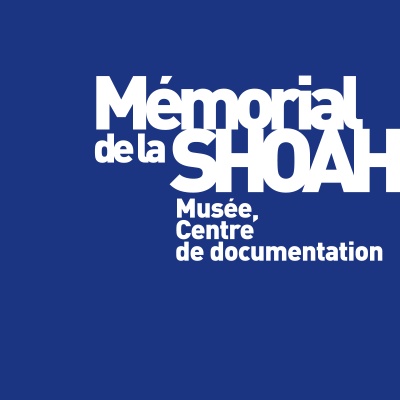31st commemoration of the genocide perpetrated against the Tutsi in Rwanda
This Monday, April 7, 2025, a commemoration ceremony was held at the Jardin de la Mémoire, in Choisy Park (Paris 13th), on the occasion of the 31st commemoration of the genocide perpetrated against the Tutsi.
Find on this occasion, the entire speech of Jacques Fredj, director of the Shoah Memorial:
We are gathered today to commemorate an absolute crime: the genocide perpetrated against the Tutsi in Rwanda in 1994. Thirty-one years ago, in the space of a hundred days, more than a million men, women and children were exterminated. Murdered not for what they had done, but for what they were.
Genocide is always the result of a racial ideology that constructs an enemy, justifies its persecution and prepares for its extermination. Before the massacres, there is therefore propaganda.
Before bullets and machetes, there are the words that kill. A hate propaganda that contributes to preparing the population.
In Rwanda, as during the Holocaust and the Armenian genocide, propaganda paved the way for crime by dehumanizing its victims. The Tutsi were called inyenzi– cockroaches -, just as the Jews of Europe were treated as vermin by the Nazi regime. It is always easier to mass murder a population set aside, excluded, dehumanized, animalized.
This propaganda that galvanized the crowds reminds us that genocide begins with words.
This language is never trivial: it always precedes the act of acting.
But commemorating a genocide is not only honoring the memory of the disappeared. It is also defending the truth.
We are going through an era, a moment when the word "genocide" is particularly often diverted from its meaning, overused, instrumentalized for political ends. However, to speak of genocide is to precisely name a crime unique in its radicality: the deliberate annihilation of a group because of what it is. To use it wrongly risks weakening our collective capacity to recognize and prevent genuine genocides.
Racial ideology, intentionality and planning are part of the common characteristics of the Genocides. The work of historians has very clearly shown the existence of a plan to eliminate Tutsi designed by extremists close to the Hutu power. In addition to the scale of the massacres, it is this planning in particular that allows for legally qualifying the events as genocide.
There is also another threat: negation. All genocides have in common their programmed erasure, whether by the executioners themselves or by their ideological heirs.
After the Holocaust, there was negationism. After the genocide of the Armenians, there was a century of denial. Even today, we are seeing speeches questioning the reality of the genocide of the Tutsi, particularly in the context of the current tensions in the Democratic Republic of Congo.
Some seek to rewrite history, minimize facts, blur responsibilities.
We know where negation leads. It opens the door to new violence. It allows the criminals of tomorrow to believe that their crime too can be erased.
This year also marks the 110° anniversary of the Armenian genocide. In 1915, in Anatolia, the Ottoman Empire implemented the systematic extermination of the Armenian people. His persistent denial taught a terrible lesson to the genocidaires of the 20th century: that one can kill a people and erase its history. In 1939, Hitler himself declared to his generals: "Who still remembers the massacre of the Armenians?"
Our responsibility is not limited to words. It is not enough to commemorate, we must also act.
In all humility, the Shoah Memorial has the honor of putting its expertise at the service of memory. The Shoah Memorial is very proud to have contributed to the classification of the archives of the association Ibuka, which brings together the survivors of the genocide. Preserving these documents means preventing forgetting and providing future generations with irrefutable evidence of what happened.
Last year, we also organized a seminar for guides of places of memory of the sites of genocide in Rwanda. The transmission of history cannot be done without those who, on site, carry the memory and make it accessible to visitors from around the world.
Finally, we work closely with the Rwandan Ministry of Memory on the development of places of remembrance and on the classification of genocide archives. Because these places are not mere vestiges of the past: they are warnings for the future. They remind the new generations that horror is never far away when hatred becomes a state policy. Finally, the conservation of archives is urgent and essential both for writing and for transmitting this history.
Transmitting is also one of the fundamental missions of the Shoah Memorial.
In this regard, I would like to warmly thank the students of Troisième at the Jorissens college in Drancy, who are there with their teachers Mrs. Isabelle Louvet and Sacha Betton.
Under our auspices and in partnership with the department of Seine-Saint-Denis, have conducted an educational project on the genocide of the Tutsi. This work of memory, coordinated by Laurine Bahloul with the director and actress Elishéva Décastel, is a valuable example of the commitment of young generations to understand, remember and fight against forgetting.
This project embodies what we must encourage: a living memory, a transmitted memory, a memory that educates and prevents.
In a few days we will read the names of the Jews deported from France at the Memorial and we will commemorate April 24, 1915, which marks the beginning of the Armenian Genocide of the Ottoman Empire.
I would like through our action and my presence to show you our solidarity, not only that which must unite all the victims of genocides but also that which comes from all women and men committed to freedom, tolerance and democracy.
To conclude, I would symbolically like to bow before the memory of the victims of the genocide against the Tutsi, women, children, men. I also have a thought for their families and for the survivors who have no other choice than to try to live with these memories, with these images of horror they were witnesses and with the absence of loved ones.
I would like to thank Ibuka for the essential work they do to keep this story alive and passed on, and thank them for their trust.
Like every year I would like to remind you on behalf of the Memorial that you can count on us.
By your side, we strongly reaffirm our commitment: to transmit and teach this history, and more generally to teach the history of genocides in order to show the consequences of racism and antisemitism, fight against forgetting, against denial, and against any attempt to instrumentalize history.
Never let the truth vacillate.
Thank you.”


